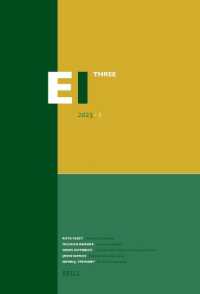Full Description
This book aims to provide readers with a sound understanding of the spectrum of radiologic appearances of bone tumors, which reflect histopathology, and the pattern analysis of imaging findings.The first part of the book explains basic concepts and diagnostic parameters, including demographics, lesion location, biological activity, matrix mineralization, and endosteal and periosteal reactions. In the second part, typical and atypical radiologic features of bone tumors are reviewed in detail, with emphasis on the characteristic radiographic and MR imaging findings and reference to schematic drawings and pathologic or operative images when appropriate.The third part focuses on problem solving in cases encountered in real radiology practice and identifies categorical patterns on the basis of radiographic and MR variables and lesion location. Informative cases are illustrated and compared to enhance understanding of differential diagnosis using pattern analysis. The final part of the bookhelps readers to consolidate what they have learned and to hone their diagnostic reasoning skills by presenting about 30 typical bone tumor cases with questions, answers, and commentary.
Contents
Part 1. Basic concepts and diagnostic parameters.- 1. Demographics.- Age.- Gender.- 2. Lesion location.- In the skeleton: Specific bones.- Axial/ Appendicular.- Within a specific bone.- Epiphysis/ Diaphysis/ Metaphysis.- Medullary space/ Cortex/ Juxtacortical.- 3. Biological activity (pattern of destruction).- Geographic.- Sclerotic margin (IA).- Well-defined border without sclerotic rim(IB).- Ill-defined border (IC).- Moth-eaten (II).- Permeated (III).- 4. Matrix mineralization.- Osteoid.- Chondroid.- Fibrous.- 5. Periosteal and endosteal reaction.- Continuous.- Shell-type.- Solid-type.- Single-layer lamellar.- Multi-lamellated (onion-skinning).- Interrupted.- Perpendicular.- Spiculated (hair-on end).- Sunburst.- Codman's triangle.- Endosteal scalloping.- 6. Size and number of the lesions.- Part 2. WHO classification of bone tumor and specific radiologic features.- 1. Osteogenic tumors.- Benign: Osteoma, Osteoid osteoma, Osteoblastoma.- Malignant: Osteosarcoma.- 2. Chondrogenic tumors.- Benign: Osteochondroma, chondromas, Chondromyxoid fibroma, Subungualexostosis and bizarre parostealosteochondromatous proliferation, Chondroblastoma.- Malignant: Chondrosarcoma.- 3. Fibrogenic and fibrohistiocytic tumors.- Desmoplastic fibroma of bone, Fibrosarcoma of bone.- Non-ossifying fibroma/Fibrous cortical defect.- Benign fibrous histiocytoma of bone.- 4. Osteoclastic giant cell-rich tumors.- Giant cell tumor of the small bones, Giant cell tumor of bone.- 5. Hematopoietic neoplasms and small round cell tumors.- Plasma cell myeloma/ Solitary plasmacytoma of bone, Primary lymphoma of bone, Ewing's sarcoma,- 6. Vascular tumors.- Haemangioma, Angiosarcoma.- 7. Others (Tumor-like lesions, Soft tissue type tumors..).- Simple bone cyst, Aneurysmal bone cyst, Fibrous dysplasia, Osteofibrous dysplasia, Langerhans cell histiocytosis, Intraosseouslipoma, Liposclerosingmyxofibrous tumor, Adamantinoma.- 8. Tumor syndromes.- Enchondromatosis: Ollier disease and Maffucci syndrome,McCune-Albright syndrome, Multipleosteochondromas.- Part 3. Practical pearls in the diagnosis of bone tumors.- Radiographic findings.- Intramedullary sclerotic bone lesions.- Cortical sclerotic bone lesions.- Geographic osteolytic lesion, sclerotic border, no intralesional matrix.- Geographic, osteolytic lesion, no sclerotic border, no intralesional matrix.- Expansileosteolytic lesion with pseudotrabeculation (Soap-bubble appearance).- Aggressive osteolytic lesions - Moth-eaten / Permeativeosteolytic lesion.- Mixed lytic and sclerotic lesions.- Chondroid matrix.- Osteoid matrix.- Pedunculated or sessile bony excrescences.- Juxtacortical/ Periosteal lesions.- 2. MRI characteristics.- Intralesional features.- Fat containing lesions.- T2 hypointense tumor matrix.- Fluid-fluid levels.- Flow voids.- Ancillary findings.- Soft tissue extension.- Intralesional or peritumoral edema.- 3. "Look like anything" lesion.- Part 4. Drill and practice: image interpretation session.








